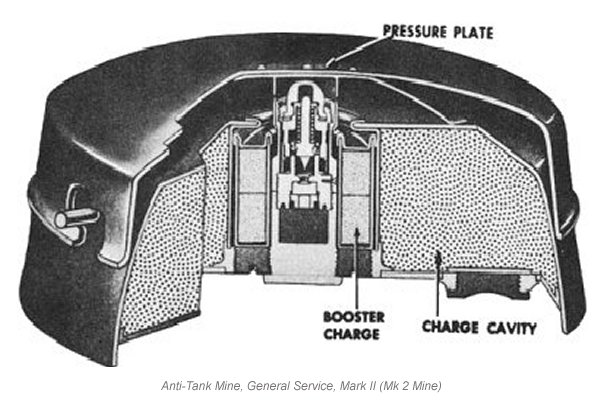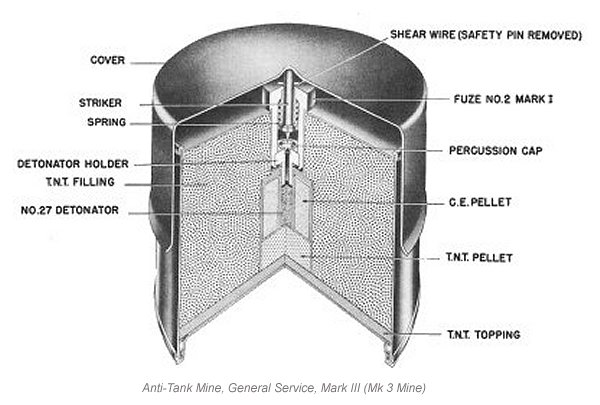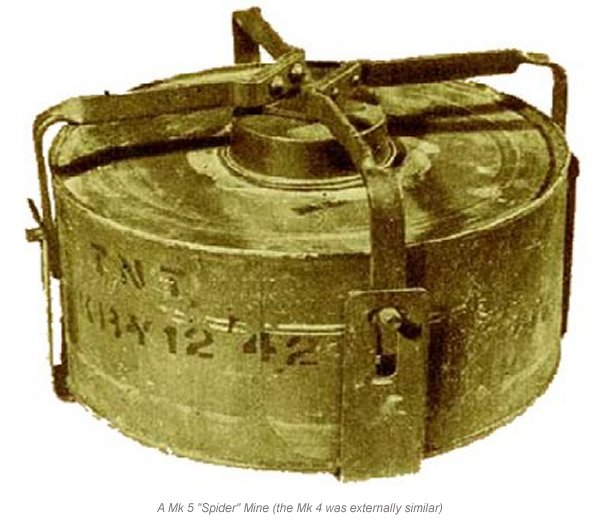yeovil at waR
mines
Weapons of the Home Guard
There are occasional references to "minefields" in Somerset, for example at Ilton, but these were exceptionally rare. Extensive minefields, such as those encountered in the North Africa campaign, were simply not even considered for use in the British countryside. Apart from the inherent danger to local communities there was the problem of the logistics of creating a minefield. Mines were easily transportable and 600 could be carried in a three-ton lorry. Certainly during the early part of the Second World War, mines were usually laid in check-wise rows at five to ten yards between rows as well as between mines. At five yard intervals, a minefield a mile long and 500 yards deep would have required 35,000 mines, or approximately 60 lorry loads.
Nevertheless, mines are frequently recorded as being used in small numbers in the vicinity of road blocks. For instance at Weycroft we know that road block S.RD.53 had 24 mines, road block S.RD.53a had 20 mines, road block S.RD.54 had 12 mines and road block S.RD.56 had 18 mines. But the small numbers of mines involved in protecting a road block are far more practicable (and a lot less dangerous to the public) than the tens of thousands that would have been required to blanket-cover the English countryside - even if they had been available. Mines would most likely have been available in limited numbers to the Yeovil Home Guard, especially during the time of the Yeovil Anti-Tank Island.
The mines used would have been either the Mark II, Mark III or Mark IV "Spider" mines detailed below. In urban areas these were simply placed on the road in front of a road block as and when needed. However at several locations in Somerset concrete mine sockets were found at the location of road blocks. Anti-tank mine sockets were made of concrete about 14" square and 9" deep with a central cylindrical socket some 5" deep to house the mine and an appropriate diameter suitable to the type of mine being used. The socket was buried in the road with its top surface level with the road surface and the mine placed in the socket. Not only did the socket provide a solid base for the mine, it also ensured that the force of the explosion was directed upwards and concentrated on the tank or vehicle setting it off. When not in use the socket would have been filled with a wooden or concrete "plug".
It is worth recounting the following memory of Eric Westman of the 10th Somerset (Bridgwater) Battalion, Polden Company, Cossington and Bawdrip Platoon of the Home Guard (quoted in Wilson, 2004) who recalled "The road was prepared for spider mines by boring 7" diameter holes in the road and fitting them with metal lids. In the event of any imminent attack the holes would be charged with mines. I remember some 10,000 holes had been drilled in the roads of Somerset to accept these mines. Sadly the holes were drilled for Mk I mines which, by the time the holes had been drilled, had been superseded by Mk II which were larger and therefore would not operate in the Mk I hole!"
In fact there was no Mk I mine, and Eric probably meant the holes were drilled for the 6" diameter Mk III mine, but the mines supplied were the 8" diameter Mk IV 'Spider' mines. However, the point is still made!
Adapted from my e-book "A Photographic Guide to the Taunton Stop Line"
gallery
Anti-Tank Mine, General Service, Mark II (Mk 2 Mine)
The Mk 2 or A/T Mine G.S. Mk II was a small, cylindrical steel cased anti-tank blast mine used for defence against light to medium tanks, armoured cars or other vehicles. The mine would break the tracks of light and medium tanks and disable other vehicles. The mine contained 4lb of TNT or Baratol and required a pressure in excess of 350lb to set it off, thus allowing an individual soldier or small animal to step on them harmlessly but when a heavier object applied pressure it would go off. The mine was 7½" in diameter and 3¼" deep.

Anti-Tank Mine, General Service, Mark III (Mk 3 Mine)
The Mk 3, or A/T Mine G.S. Mk III, was an anti-tank blast mine with a tin body and a steel cover used for defence against light to medium tanks, armoured cars or other vehicles. Like the Mk II, the Mk III would break the tracks of light and medium tanks and disable other vehicles. The mine contained TNT and, like the Mk II, required a pressure in excess of 350lb to set it off, thus making it dangerous only to vehicles. The mine was 6" in diameter, 5¼" deep and weighed a total of 5lbs10oz.

Anti-Tank Mine, General Service, Mark IV (Mk 4, or "Spider" Mine)
The Mk 4, or A/T Mine G.S. Mk IV, commonly known as the "Spider" mine, was an anti-tank blast mine with a tin body and a steel cover used for defence against light to medium tanks, armoured cars or other vehicles. The mine was covered by a pressure plate, which was attached to the mine body by four pins which sat in vertical slots in clips that fold up from the bottom of the mine. The mine contained TNT and, like the Mk II and Mk III, required a pressure in excess of 350lb to set it off. The Mark 4 was 8" in diameter, 5¼" deep and weighed a total of 8lbs 2oz. The mines came packed in a wooden box, five to a box with 20 fuses stored separately.
